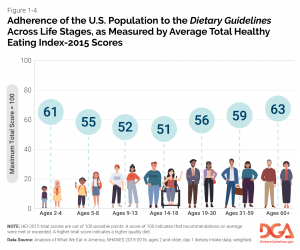by Theresa Ferrari, Extension Specialist, 4-H Youth Development
Happy birthday, MyPlate! MyPlate is 10 years old this year. It’s a good reminder to think about how we can use MyPlate concepts. How does your plate stack up to MyPlate?
![]() What is MyPlate? MyPlate is a nutritional food guide that was developed by the U.S. Department of Agriculture to help people become more aware of what they eat and to assist them in making better food choices. The MyPlate icon shows the five food groups: Fruits, Vegetables, Grains, Protein Foods, and Dairy. It features a simple picture of a plate, which offers a visual cue that is easy to relate to, with sections of a plate representing how much of each food group people should consume relative to the other groups.
What is MyPlate? MyPlate is a nutritional food guide that was developed by the U.S. Department of Agriculture to help people become more aware of what they eat and to assist them in making better food choices. The MyPlate icon shows the five food groups: Fruits, Vegetables, Grains, Protein Foods, and Dairy. It features a simple picture of a plate, which offers a visual cue that is easy to relate to, with sections of a plate representing how much of each food group people should consume relative to the other groups.
The 2020–2025 Dietary Guidelines for Americans emphasizes the importance of an overall healthy eating pattern with all five groups as key building blocks. Each food group includes a variety of foods that are similar in nutritional makeup, and each group plays an important role in an overall healthy eating pattern.
Current intakes show that from an early age, dietary patterns are not aligned with the Dietary Guidelines.
- Average intakes for 5- to 8-year-olds are generally within the range of recommended intakes for protein, fruits, and grains (although this is achieved with refined grains, not whole grains), but below in vegetables and dairy.
- Diet quality declines for the 9- to 13-year-old and 14- to 18-year-old age groups. Grains are within the recommended range, again with whole grains below recommended amounts. Protein foods are at the lower limit of the recommended intake (with older teen girls dropping below). Fruit intake drops, and vegetables and dairy remain low.
- The difference between recommended food group amounts and current intakes is greater for adolescents ages 14 through 18 than for any other age group across the lifespan. As a result, adolescents are at greater risk of dietary inadequacy than are other age groups.
- Vegetable intake is especially low and increasing vegetable consumption tends to be particularly difficult. In addition, most diets exceed the recommended limits for added sugars, saturated fat, and sodium.
A recent study found that diets of children in the U.S. have improved modestly but remain poor for most. This improvement in diet quality is promising. However, another report found that more than a third of U.S. children and adolescents consumed fast food. Other researchers have examined sugar-sweetened beverages and junk foods. The results of these studies are cause for concern because fast food, sugar-sweetened beverages, and junk foods have been associated with higher caloric intake and poorer diet quality. These dietary patterns contribute to overweight and obesity, as well as increasing the risk for chronic diseases later in life.
MyPlate Talking Points
- Fruits – Make half your plate fruits and vegetables: Focus on whole fruits.
- Vegetables – Make half your plate fruits and vegetables: Vary your veggies.
- Grains – Make half your grains whole grains.
- Protein – Vary your protein routine. Choose protein foods like beans, fish, lean meats, and nuts.
- Dairy – Move to low-fat or fat-free milk or yogurt. Drink fat free or low-fat milk or water instead of sugary drinks.
MyPlate is not perfect–for one thing, the size of the plate matters. The specific amounts of food needed in each group vary by age, gender, and activity level; the Dietary Guidelines provides more detailed information on this topic. Some foods contain ingredients from multiple groups, making them difficult to classify.
The MyPlate icon focuses on incorporating healthful foods; however, all foods in a group are not the same. Foods vary in their nutrient density, that is, the amount of key nutrients they provide relative to the energy (calories) they provide. The key is choosing a variety of foods and beverages from each food group. Nutrients to encourage include protein, fiber, and a range of vitamins and minerals, while those to limit are saturated fat, added sugars, and sodium. That includes cakes, cookies, ice cream, candies, sweetened drinks, and fatty meats like sausages, bacon, and hot dogs. Use these foods as occasional treats but not everyday foods (think of them as “sometimes foods”). Although they do not identify the nutrient density as such, the nutrition facts label can help in identifying specific nutrient content.
Today’s Takeaway: Developing healthy eating habits can go a long way to ensure a better lifestyle now and in the future. MyPlate provides a guide for making healthful choices.

References
Drewnowski, A. (2009). Defining nutrient density: Development and validation of the Nutrient rick Foods Index. Journal of the American College of Nutrition, 28(4) 421S–426S. https://doi.org/10.1080/07315724.2009.10718106
Fryar, C. D., Carroll, M. D., Ahluwalia, N., & Ogden, C. L. (2020). Fast food intake among children and adolescents in the United States, 2015–2018 (NCHS Data Brief No. 375). https://www.cdc.gov/nchs/products/databriefs/db375.htm
Gold, A., Larson, M., Tucker, J., & Strang, M. (2017). Classroom nutrition education combined with fruit and vegetable taste testing improves children’s dietary intake. Journal of School Health, 87(2), 106–113. https://doi.org/10.1111/josh.12478
Leung, C. W., DiMatteo, S. G., Gosliner, W. A., & Ritchie, L. D. (2018). Sugar-sweetened beverage and water intake in relation to diet quality in U.S. children. American Journal of Preventive Medicine, 54(3), 394–402. https://doi.org/10.1016/j.amepre.2017.11.005
Liu, J., Rehm, C. D., Onopa, J., & Mozaffarian, D. (2020). Trends in diet quality among youth in the United States, 1999-2016. Journal of the American Medical Association, 323(12), 1161–1174. https://doi.org/10.1001/jama.2020.0878
Liu, J., Lee, Y., Micha, R., Li, Y., & Mozaffarian, D. (2021). Trends in junk food consumption among US children and adults, 2001-2018. American Journal of Clinical Nutrition, nqab129. https://doi.org/10.1093/ajcn/nqab129
Snelling, A. M., Newman, C., Ellsworth, D., Kalicki, M. Guthrie, J., Mancino. L., Malloy, E., Van Dyke, H., George, S., & Nash, K. (2017). Using a taste test intervention to promote vegetable consumption. Health Behavior and Policy Review, 4(1), 67–75. https://doi.org/10.14485/HBPR.4.1.8
U.S. Department of Agriculture. MyPlate. https://www.myplate.gov/
U.S. Department of Agriculture and U.S. Department of Health and Human Service. (2020). Dietary guidelines for Americans, 2020–2025 (9th ed.). https://www.dietaryguidelines.gov/





